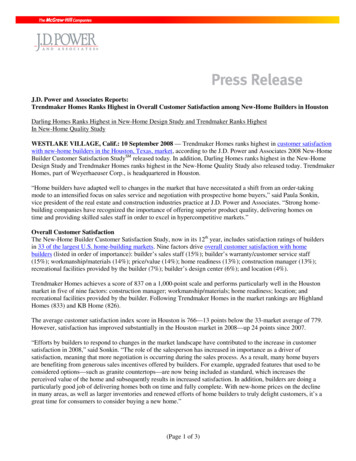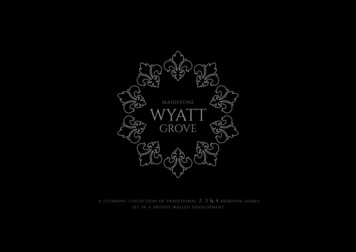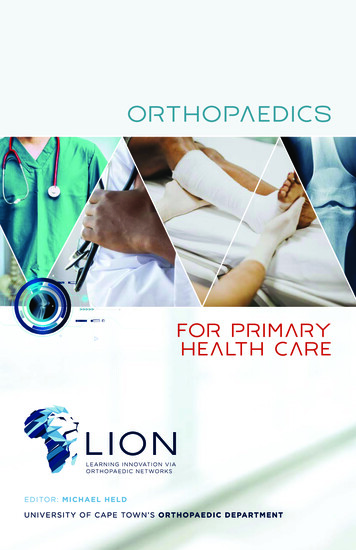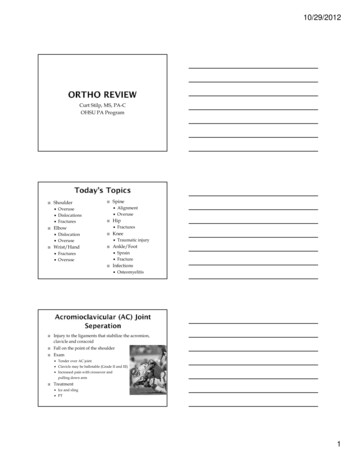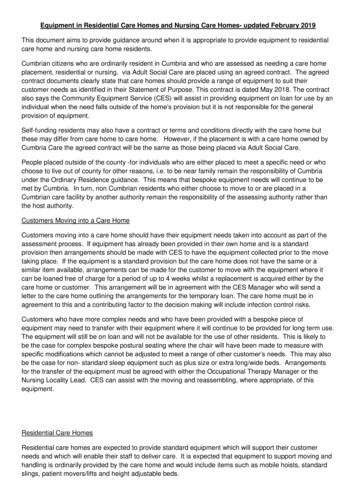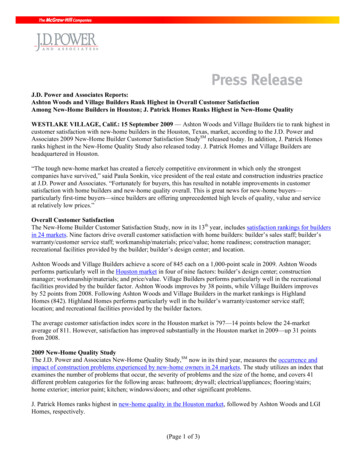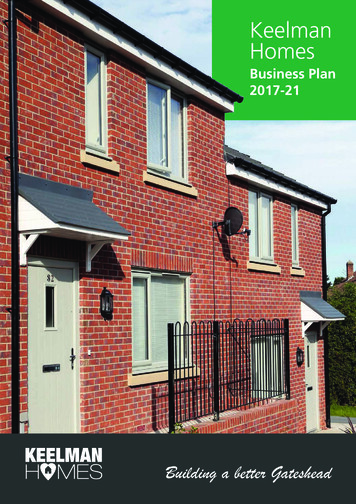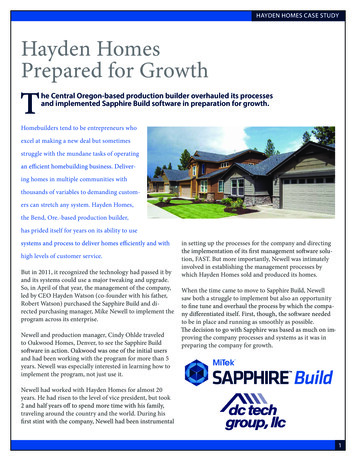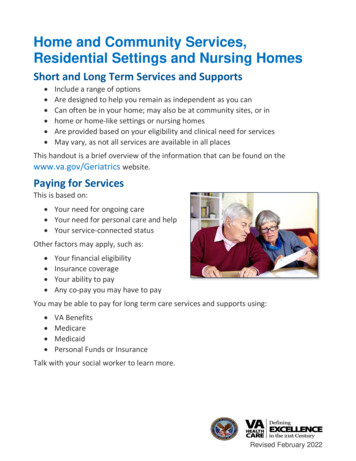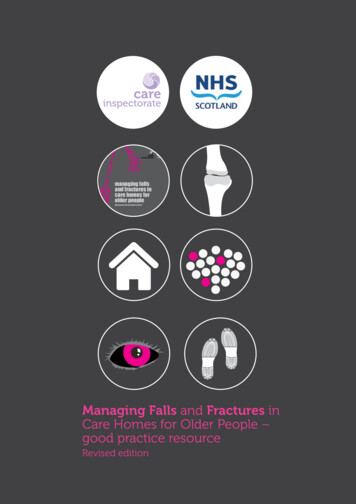
Transcription
managing fallsand fractures incare homes forolder peopleGood practice self assessment resourceManaging Falls and Fractures inCare Homes for Older People –good practice resourceRevised editionManaging Falls and Fractures in Care Homes for Older People – good practice resource1
2Managing Falls and Fractures in Care Homes for Older People – good practice resource
ContentsForeword 4Background 6Using the resource pack to improve care8Section 1: Introduction to falls and fractures10Section 2: Guidance for improving the quality of care18Section 3: Prevention of falls and fractures27Section 4: Keeping well – learning more about risk factors and howto prevent falls and fractures 34 Keeping physically active and mobile34 Mild cognitive impairment, dementia and delirium39 Managing medication43 Continence45 Keeping feet healthy50 Dizziness, blackouts and heart palpitations53 Vision and hearing56 The environment59 Nutrition and hydration67 Keeping bones healthy71Section 5: Management of falls and fractures The immediate care after a resident has fallen Learning from falls787882Section 6: Working together 90Section 7: Education and written guidanceAcknowledgements9395Managing Falls and Fractures in Care Homes for Older People – good practice resource3
ForewordFalls and the consequences of falls can significantly impact a person’s wellbeing, mobility andconfidence. In Scotland, falls are a major and growing concern for older people, their families andcarers as well as health and social care providers.Older people living in care homes are three times more likely to fall than older people living in theirown homes, with the results of these falls often being more serious. Many factors can contribute tothis heightened risk, such as physical frailty, the presence of long term conditions, physical inactivity,taking multiple medications and the unfamiliarity of new surroundings. However, in many cases takingthe right steps at the right time can actively support an individual and reduce the risk of falls andharm from falls.The ‘Managing Falls and Fractures in Care Homes for Older People – good practice resource’,published in 2011, has provided direction, advice and support to managers and staff in care homes forolder people across Scotland. The resource has helped staff to understand the importance of taking aproactive approach to preventing falls and to support older people to have a physically active life.The interaction of factors that contribute to an individual’s risk of falling is unique to them. For thisreason, it is important care homes for older people have a person centred approach to manage andprevent falls and fractures. This helps to improve the overall quality of care for an individual and has ahuge impact on a person’s level of independence, participation and enjoyment in life. Feedback fromcare home staff, the wider health and social care team and inspectors tells us that the resource packis one of the things that has helped care homes to do this.The Scottish Government’s ‘Up and About in Care Homes’ project, during which the project teamworked with a number of care homes across Scotland, helped to identify what is important for carehome staff to know in order to manage and prevent falls and fractures, and how best they can besupported to use the resource pack. This revised edition takes this learning into consideration. Itcontinues to offer care homes a self assessment to complete which, along with other informationthey may have on falls, can be used to develop an improvement plan that will measure the impactof changes on individuals as well as building staff knowledge, competency and confidence. The goodpractice guide has been updated, with more detail added where it was needed, along with someadditional tools and resources.A new section in this edition is, ‘Guidance for improving the quality of care’. This has been addedto support care homes to make improvements to how they manage falls, as well as prevent fallsand fractures, using tried and tested approaches. It will help care homes to identify, plan, test andimplement lasting improvements to successfully manage and prevent falls and fractures and supporta person’s wellbeing, independence, and participation in order to live as well as they possibly can. This4Managing Falls and Fractures in Care Homes for Older People – good practice resource
fits well with the Care Inspectorate’s approach to scrutiny, which includes supporting care homes tomake identified improvements in the quality of care, for example through specific pieces of work withservices or signposting to good practice and helpful resources.Over the last few years, there has been much work done, nationally and locally, to support care homesfor older people to make improvements in this area of care. More people than ever understand andacknowledge that the risk of and harm from falls can be successfully managed. Key ingredients forsuccess have been identified, such as strong leadership, working more closely with the local health andsocial care team, collecting and analysing falls data and having adequate resources.We are delighted that significant improvements have been made in care homes since 2011 and asa result many falls have been prevented. The revised edition of this national resource pack is nowavailable to support care homes to continue to identify and make improvements which are sustainable,and remind people ‘falls prevention is everyone’s business’. Ultimately this will improve the overallquality of care for older people in care homes in Scotland and support people to enjoy life and live well.Karen Reid Tracy MacInnesChief Executive Acting CHPOCare Inspectorate Scottish GovernmentManaging Falls and Fractures in Care Homes for Older People – good practice resource5
BackgroundThe prevention and management of falls and the prevention of fractures is an important issue inmaintaining quality of life and independence for older people. This includes older people in care homes.In 2011 the ‘Managing Falls and Fractures in Care Homes for Older People – good practice resource’was published by the Care Inspectorate and NHS Scotland and issued to all care homes for older peoplein Scotland. The resource pack aimed to support care homes across Scotland to manage and preventfalls and prevent fractures with an emphasis on person-centred care and continuous improvement.An evaluation showed that where the resource was used by care home staff working in partnershipwith the wider health and social care team, there was improved person-centred falls prevention andmanagement and a significant reduction in falls.In 2014/15, the Scottish Government funded an 18 month improvement project called, ‘Up and Aboutin care homes’. This project supported 38 care homes in Scotland to use the resource pack togetherwith improvement methods and tools. The project succeeded in developing and testing innovative waysof working to improve care. Participating care homes found that taking a proactive team approach toimprovement, using the resource, reduced their residents’ falls and injuries due to falls.In 2014, the Scottish Government published ‘The Prevention and Management of Falls in theCommunity. A Framework for Action for Scotland 2014-16’1. The Framework aims to support a moreconsistent approach to falls prevention and management and in doing so improve experiences andoutcomes for older people, their families and carers. It recommends an integrated and co-ordinatedapproach focusing on the four stages of the Up and About Pathway (figure 1). This resourcesupports care home staff to adopt the approach set out in the Framework, for older people living incare homes.1 Scottish Government (2014) The prevention and management of falls in the community a framework for action forScotland 2014/2015 ging Falls and Fractures in Care Homes for Older People – good practice resource
Figure 1 Up and About PathwayStage oneSupporting active ageinghealth improvementand self managementStage fourCoordinated managementincluding specialistassessmentStage twoIdentifying high riskof falls and/orfragility fracturesStage threeResponding to anindividual who has justfallen and requiresimmediate assistanceThe Care Inspectorate has been reviewing its methodology and inspection processes. With anincreased focus on supporting improvement, inspectors promote and reinforce good practice which isdetailed in the resource pack.The revised edition of the resource pack has been updated and improved using the learning from the‘Up and About in care homes’ project along with input from subject matter experts, care home staff,inspectors, local falls leads and the wider health and social care team. The resource pack continues toprovide a self assessment to identify areas for improvement. There are new sections on how to makeimprovements and keeping well, and a range of new links and tools.Managing Falls and Fractures in Care Homes for Older People – good practice resource7
Using the resource pack to improve careWhat is the purpose of the resource pack?This resource is for you if you are supporting older people in a care home, whether you are care homestaff or part of the wider team. It will help you to take a proactive approach to preventing andmanaging falls and preventing fractures.This resource pack will help you to: recognise quality care you are already giving identify and prioritise areas for improvement test out and put into practice (implement) new ways of working that both staff and residents willbenefit from maintain the improvements you have implemented.Sections of the resource pack can also be used during staff induction and training to raise awareness,increase knowledge and understanding, and involve everyone in your care home in falls prevention andmanagement and fracture prevention.Read more about using the pack to educate care home staff about falls and fractures in the section‘Education and written guidance’ on pages 93-94.What does the resource pack include?This table lists the sections in the resource pack and summarises information included in each section.SectionIncludesIntroduction to falls and fractures Why falls prevention and management matters.(page 10) Why falls happen. How falls and fractures can be prevented.Guidance for improving the How to identify areas for improvement.quality of care How to use the self assessment.(page 18) How to plan, test, implement and evaluate the changes youmake. How to make improvement last.Prevention of falls and fractures How to use multifactorial falls risk screening to recognise and(page 27)reduce individual resident’s risk of falling. How to take simple steps to reduce the risk of everyone in thecare home falling.8Managing Falls and Fractures in Care Homes for Older People – good practice resource
SectionKeeping well: learning moreabout risk factors and how toprevent falls and fractures(page 34)Management of falls andfractures(page 78)Working together(page 90)Education and written guidance(page 93)Falls prevention andmanagement toolsIncludes How to identify and manage key risk factors for falls andfractures. How to provide immediate care after a resident has fallen. How to learn from falls to improve care, prevent further fallsand reduce harm from falls. How to build and strengthen links with the wider health andsocial care team, other care homes and the community to sharelearning and improve care. How to improve the knowledge and skills of staff in your carehome to improve care. A range of tools that can be used to improve aspects of themanagement and prevention of falls and the prevention offractures.You can dip in and out of the resource pack and use what is helpful to you.Falls prevention and management toolsThere are a number of tools included in this resource. You can download the tools and use them freelyto help you to improve the management and prevention of falls and the prevention of fractures in yourcare home. Completing the self assessment will direct you to the tools that may be appropriate andhelpful.Read more about the self assessment in Section 2.A tool in the pack may be similar to one that you use in your care home already. It may be useful tocompare the two. As a result you may continue to use your existing tool or change to the new tool.We do not expect you to use all the tools unless you find it necessary.How do you know where to start?Before you start your improvement journey, it is essential that everyone in your care homeunderstands why falls prevention and management are important and that many falls are preventable.Reading the Introduction to falls and fractures (Section 1) will help you to understand why falls matter.The next step is to identify areas of falls prevention and management and fracture prevention in yourcare home that need to be improved. This is covered in Section 2 ‘Guidance for improving quality ofcare’ and Section 5 ‘Learning from falls’.A well-planned, structured approach to improvement will give you a better chance of being successful.Figure 5 (page 20) summarises the structured approach to improvement recommended in thisresource pack. Section 2 ‘Guidance for improving the quality of care’ will guide you to use triedand tested quality improvement methods and tools, together with this resource, to make lastingimprovements in your care home.Managing Falls and Fractures in Care Homes for Older People – good practice resource9
Section 1: Introduction to falls and fracturesKey things to remember Falls can be a serious problem, resulting in suffering, disability, loss of independence anddecline in quality of life. A common definition of falls should be used in your care home (see definition below). Aim to prevent falls while (a) preserving as much of the residents’ independence as possible,(b) continuing to encourage safe physical activity, and (c) maximising quality of life. Do not accept falls as an inevitable part of getting older; many falls are preventable. A fall is nearly always due to one or more ‘risk factors’. Recognising these and then removingor reducing an individual’s risk factors can often prevent a fall. If a person has osteoporosis, they are more likely to break a bone if they fall. Falls and bonehealth need to be considered together.Preventing falls while maintaining quality of lifeWhen caring for older people, preventing falls and injuries from falls is a priority. However, you need toachieve this while still enabling your residents to be as independent as possible. You should continueto encourage safe physical activity and achieve the best quality of life possible. This can be a challengebut should be your approach at all times.Many actions care home staff take to prevent falls will also have wider benefits for the older person,such as improving physical and mental health, general well-being, independence and the ability to carryout activities that are important to them.Definition of a fall (D5 in the self assessment)It is important to use a common definition of falls within your care home to help everyone to understand what a fall is and to report and record all falls consistently.Seeking a simple, comprehensive and inclusive definition of a fall to guide research programmes, thePrevention of Falls Network Europe (ProFaNE) and Outcomes Consensus Group2 recommended a fall isdefined as:‘an unexpected event in which the participant comes to rest on the ground, floor, or lower level’(The World Health Organization definition of a fall uses nearly identical wording3.)2 Lamb SE, Jorstad-Stein EC, Hauer K et al. (2005) Development of a common outcome data set for fall injury preventiontrials: The Prevention of Falls Network Europe Consensus. Journal of the American Geriatrics Society 53: p.1618–223 World Health Organization (2012) Falls Fact Sheet No 344. www.who.int/mediacentre/factsheets/fs344/en/ (accessed 3April 2016).10Managing Falls and Fractures in Care Homes for Older People – good practice resource
This definition excludes ‘trips’, which do not result in a person coming to rest on the ground becausebalance is regained successfully.It is useful to include unwitnessed falls in your reporting. Although in some cases the resident willhave placed themselves intentionally on the floor, not including unwitnessed falls in your reportingmay mean that you miss an opportunity to learn from the incident and prevent further falls.Why falls matterEach year around one third of people over 65 experience one or more falls. Almost half of peopleaged over 80 living in the community fall each year4. Falls rates among care home residents are muchhigher than among older people living in their own homes.Falls can result in suffering, disability, loss of independence and a decline in quality of life.Most people experience a fall at some point in their life which often results in little more thanembarrassment. However, as we get older falls can become more common and the consequences of afall can become much more serious. Injury caused by falls is the leading cause of accidental death forpeople over 75.As well as causing pain and distress, an injury caused by a fall can result in a person temporarily losingthe ability to carry out their usual daily activities. For a frailer older person, this can quickly become apermanent loss.Falls can result in psychological as well as physical harm. Whether or not there has been an injury, afall can result in a person losing their confidence and becoming anxious and fearful of falling again.Another cause of both physical and psychological harm following a fall is a long period of time spenton the floor waiting for assistance. Serious consequences include pressure sores, hypothermia anddeveloping a deep fear of further falls.Think about a resident you know who has fallen. What was the impact for them?Figures 2 and 3 (page 12) show some of the physical and psychological consequences of a fall and/ora prolonged length of time lying on the floor.Falls also matter for a frail older person because they can be the first sign of a new or worseninghealth problem, such as an infection or a heart problem. A fall is a symptom not a diagnosis.4 Department of Health (2009) Falls and Fractures: Effective interventions in health and social care ads/2011/12/FF pdfManaging Falls and Fractures in Care Homes for Older People – good practice resource11
Figure 2: physical consequences of a fall and/or a prolonged length of time lying on the floorDeathImmobilityIncontinenceCuts, bruises, softtissue injuriesHypothermiaDehydrationPhysicalPressure ulcers/leg ulcerationFracturesPneumonia/chest infectionDislocationHead injuriesFigure 3: psychological consequences of a fall and/or a prolonged length of time lying on thefloorLoss ofconfidenceAnxiety/depressionFeelings of uselesnessIncreasedCarer stressdependencyPsychologicalEmotionalstressLoss of controlSocial isolation/withdrawalEmbarassmentLowFear ofself-esteem further fallsFear of fallingIt is common for an older person who has fallen to become fearful of falling again. A resident whohas never fallen may also be frightened of falls. People who are fearful about falls often avoid physicalactivity, become weaker, and may fall more as a result. A vicious cycle can result - see figure 4. Takefear of falling seriously and when required, request advice from a health professional with knowledgeof fear of falling.12Managing Falls and Fractures in Care Homes for Older People – good practice resource
Figure 4 The vicious cycle of fallsIncreaserisk offallingDecreasedmuscle strengthand balanceFALLVICIOUSCYCLEFear offalling againReducedactivityRosemary’s story about the consequences of fallsRosemary was admitted to the care home from hospital where she had been recovering from injuriesshe sustained after a fall at home. She initially settled in well to the care home, however, she had afall in the corridor which led to severe bruising of her face. She subsequently had another eight fallsin eight weeks. Although she didn’t sustain any broken bones, she suffered further cuts and bruises.Her family were very upset by this. The care home staff noticed that Rosemary stopped walking to thecommunal areas for her meals and social events. When they asked Rosemary about it she said she had“lost her confidence” and “felt useless”. Staff were very concerned as she seemed to be sitting moreand then had two urinary tract infections. They were concerned to see the deterioration of her physicaland mental wellbeing.Falls in care homesIn 2006, Help the Aged published a booklet called ‘Preventing Falls. Managing risk and effect of fallsamong older people in care homes’.5 It identified these reasons why falls in care homes are costly.5 Help the Aged (2006) Preventing Falls. Managing the risk and effect of falls among older people in care pdfManaging Falls and Fractures in Care Homes for Older People – good practice resource13
Older people living in care homes are three times more likely to fall than older people living inthe community. 25% of older people who fall in care homes suffer serious injuries. 40% of hospital admissions from care homes follow a fall. Litigation may suggest a breach of the duty of care. Complaints about falls create negative publicity. Emergency action after a fall diverts staff from planned care. Care to relieve injuries and anxiety from a fall increases workloads.Falls can also have a negative impact on staff, with feelings of anxiety and guilt and low staff morale.Falls and injuries from falls, including hip fractures, are more common in care homes because: residents of care homes are more likely to be physically frail residents may be physically inactive, resulting in weak muscles and poor balance many residents have long term medical conditions which can increase their risk of falling such asstroke, Parkinson’s disease, arthritis, depression and dementia residents may be taking a number of medications newer residents are unfamiliar with their new surroundings.Although falls are common and the impact of falls can be very serious, the good news is that many fallsare preventable.Many falls are preventableAs we get older, we often accept that falls are unavoidable, however this is not the case. Most peopleover 65 do not fall each year. Falls are not an inevitable part of ageing. A fall is always due to thepresence of one or more ‘risk factors’.Falls prevention is about recognising a person’s falls risk factors then, where possible, removing orreducing them.The risk of falling can never be completely removed, but by carrying out a multifactorial falls risk screen(MFRS) with a resident, their risk factors can be identified and action taken to remove or reduce riskwhere possible. Considering environmental risks within the care home is part of this process.There will be cases when an individual remains at high risk of falling despite thorough screening,assessment and management. In these instances, you can try to reduce the risk of harm from fallsby using suitable equipment and alarm systems (pages 62-67), ensuring residents take osteoporosismedications as prescribed (page 76), and following post fall protocols (page 78-81).In your care home, the emphasis should be on anticipating and preventing falls rather than simplymanaging falls once they have occurred.14Managing Falls and Fractures in Care Homes for Older People – good practice resource
Risk factors for fallingRisk factors can be personal (relating to an individual) and/or related to the surrounding environment.The more risk factors present, the greater the risk of falling.Personal risk factors can be present as a result of: changes in the body caused by the normal ageing process certain medical conditions the side-effects of some medications or a combination of many excessive alcohol being physically inactive.Personal risk factors include: weak muscles, unsteadiness (poor balance) and/or difficulty walking and moving around slowed reactions foot problems numbness in the ankles and feet vision and hearing problems dizziness or blackouts seizures continence problems fear of falling pain cognitive problems, such as memory loss, lack of awareness of safety, a person not knowing theirown limits and risk, impulsive behaviour, confusion (acute or chronic) and reduced understanding.Environmental risk factors include: poor lighting, especially on stairs low temperature wet, slippery or uneven floor surfaces clutter chairs, toilets or beds being too high, low or unstable inappropriate or unsafe walking aids inadequately maintained wheelchairs, for example, brakes not locking improper use of wheelchairs, for example, failing to clear foot plates unsafe or absent equipment, such as handrails loose fitting footwear and clothing.Certain activities can be ‘high risk’ because of the specific interaction of risk factors involved, forexample, getting up to use the toilet at night. Risk could relate to a person’s strength, balance andwalking, but also to their inability to use a call bell to get help, lack of lighting and lower staffing levelsat night.Managing Falls and Fractures in Care Homes for Older People – good practice resource15
A number of residents within a care home will need assistance with walking and other day-to-dayactivities, such as washing, dressing, getting in and out of a chair or bed and using the toilet. Therefore,staffing levels, staff work patterns and the staff’s knowledge and awareness of falls prevention canaffect the risk of falls in a care home.Specific conditions can increase risk of fallingAs well as the risk factors listed above, a number of acute or temporary health conditions can increasethe risk of falling. This is due to the effect of the condition on a resident’s physical and mental function.Conditions include: constipation acute infection including a urinary tract infection, chest infection or pneumonia dehydration delirium (sudden severe confusion and rapid changes in brain function that occur with physical ormental illness).Care home staff should know that there is an increased risk of falls if one or more of these conditionsare present. Similarly, staff should consider these conditions when trying to find the underlying cause ofa resident’s fall.Dizziness, blackouts and heart palpitationsIn some cases dizziness, blackouts or palpitations may occur before a fall. Always ask the resident ifthey had any of these symptoms before they fell. Sometimes a resident will not remember a blackout.If possible, speak to someone who witnessed the fall. Read more about this in the section on ‘Dizziness,blackouts and heart palpitations’ on pages 53–55.Falls, broken bones and osteoporosisIf a person has a weakness in their bones, for example if they have osteoporosis, he or she is at greaterrisk of breaking a bone at the time of a fall. A hip fracture caused by a fall can lead to considerablesuffering for an older person, loss of the ability to get about on their own and greater dependence onothers to carry out day-to-day activities.For this reason, you need to consider falls prevention, bone health and the diagnosis and managementof osteoporosis together. Read more about this in the section on ‘Keeping bones healthy’ pages 71–77.Frailty and fallsIf a resident is falling, it may be an indication that they are becoming frail. Immobility, delirium,incontinence and an adverse reaction to medication can also indicate that a person is frail. Frailty isnot always a permanent state. If you suspect a resident is becoming frail consider asking for a medicalreview – there may be interventions that can help.16Managing Falls and Fractures in Care Homes for Older People – good practice resource
People who are frail have less ‘in reserve’ so are less able to withstand illness without a loss ofphysical or cognitive function. Therefore, for a person with frailty, a relatively minor illness such as acold, a urinary tract infection or even constipation can cause reduced mobility and confusion. This canlead to an increased risk of falling. It is important that staff are aware of this and decide how best tomanage risk while the person is unwell.Dementia and fallsIndividuals with a level of cognitive impairment with or without a dementia diagnosis are anincreasingly large group of people within care homes. Due to the loss of a person’s cognitive abilities,there can be an increased risk of falls. Read more about this in the section on ‘mild cognitiveimpairment, dementia and delirium’ on page 39.Managing Falls and Fractures in Care Homes for Older People – good practice resource17
Section 2: Guidance for improving thequality of careThis section will help you to identify, plan, test and implement lasting improvements in your care hometo successfully manage and prevent falls and prevent fractures.Key things to remember The aim of improvement activity in care homes is to make the care you provide better. Improvement in the quality of care doesn’t happen by accident; it needs to be planned andstructured and takes time. Making improvements should benefit your residents, staff and the organisation. Essentials for achieving successful improvements include a belief that falls are a problemworth solving, strong leadership, clinical support, adequate resources, a dedicatedimprovement team and making falls and improvement everyone’s business. A well-planned approach to improvement will give you a better chance of being successfuland maintaining improvements. Using the self assessment in this resource and learning from any falls in your care home aretwo effective ways of identifying
Care Homes for Older People - good practice resource Revised edition managing falls and fractures in care homes for older people . supports care home staff to adopt the approach set out in the Framework, for older people living in care homes. 1 Scottish Government (2014) The prevention and management of falls in the community a framework .
